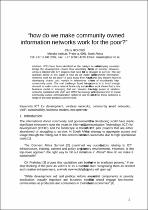JavaScript is disabled for your browser. Some features of this site may not work without it.
- ResearchSpace
- →
- Research Publications/Outputs
- →
- Conference Publications
- →
- View Item
| dc.contributor.author |
Morris, CF

|
|
| dc.date.accessioned | 2010-07-23T14:28:11Z | |
| dc.date.available | 2010-07-23T14:28:11Z | |
| dc.date.issued | 2009 | |
| dc.identifier.citation | Morris, CF. 2009. How do we make community owned information networks work for the poor?. IST-Africa 2009 Conference and Exhibition, Kampala, Uganda, 6-8 May 2009, pp 8 . | en |
| dc.identifier.isbn | 9781905824113 | |
| dc.identifier.uri | http://hdl.handle.net/10204/4126 | |
| dc.description | IST-Africa 2009 Conference and Exhibition, Kampala, Uganda, 6-8 May 2009 | en |
| dc.description.abstract | ICTs have been identified as the catalyst to assist developing countries bridge the development chasm thus alleviating the effects of poverty. However, Africa is littered with ICT projects that have failed or struggle to survive. The key question asked in this paper is how do we make community owned information networks work for the poor? A case study from Angola shares key lessons learnt in developing shared cost models in telecentres in the face of exorbitantly high connectivity costs. The real challenge faced by such projects is to build enough demand to make such a network financially sustainable. New work shows that a new business model is emerging that can harness the expanding power of wireless networks combined with VoIP and WISP technology and entrepreneurship to create community-owned communication networks and to provide over these networks a range of pro-poor products and services. | en |
| dc.language.iso | en | en |
| dc.publisher | IST Africa 2009 | en |
| dc.subject | ICT development | en |
| dc.subject | Wireless networks | en |
| dc.subject | Community owned networks | en |
| dc.subject | VoIP technology | en |
| dc.subject | Sustainability | en |
| dc.subject | Business models | en |
| dc.subject | WISP technology | en |
| dc.subject | IST Africa 2009 | en |
| dc.title | How do we make community owned information networks work for the poor? | en |
| dc.type | Conference Presentation | en |
| dc.identifier.apacitation | Morris, C. (2009). How do we make community owned information networks work for the poor?. IST Africa 2009. http://hdl.handle.net/10204/4126 | en_ZA |
| dc.identifier.chicagocitation | Morris, CF. "How do we make community owned information networks work for the poor?." (2009): http://hdl.handle.net/10204/4126 | en_ZA |
| dc.identifier.vancouvercitation | Morris C, How do we make community owned information networks work for the poor?; IST Africa 2009; 2009. http://hdl.handle.net/10204/4126 . | en_ZA |
| dc.identifier.ris | TY - Conference Presentation AU - Morris, CF AB - ICTs have been identified as the catalyst to assist developing countries bridge the development chasm thus alleviating the effects of poverty. However, Africa is littered with ICT projects that have failed or struggle to survive. The key question asked in this paper is how do we make community owned information networks work for the poor? A case study from Angola shares key lessons learnt in developing shared cost models in telecentres in the face of exorbitantly high connectivity costs. The real challenge faced by such projects is to build enough demand to make such a network financially sustainable. New work shows that a new business model is emerging that can harness the expanding power of wireless networks combined with VoIP and WISP technology and entrepreneurship to create community-owned communication networks and to provide over these networks a range of pro-poor products and services. DA - 2009 DB - ResearchSpace DP - CSIR KW - ICT development KW - Wireless networks KW - Community owned networks KW - VoIP technology KW - Sustainability KW - Business models KW - WISP technology KW - IST Africa 2009 LK - https://researchspace.csir.co.za PY - 2009 SM - 9781905824113 T1 - How do we make community owned information networks work for the poor? TI - How do we make community owned information networks work for the poor? UR - http://hdl.handle.net/10204/4126 ER - | en_ZA |






